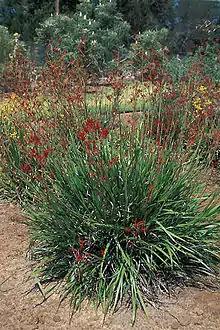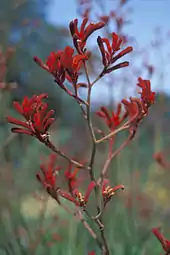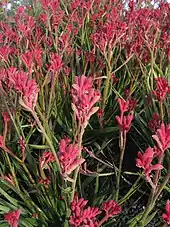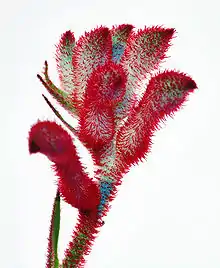Anigozanthos
Anigozanthos is a small genus of Australian plants in the bloodwort family Haemodoraceae. The 11 species and several subspecies are commonly known as kangaroo paw and catspaw depending on the shape of their flowers. A further species, previously identified as Anigozanthos fuliginosus and commonly known as the black kangaroo paw, has been transferred to its own monotypic genus and is now known as Macropidia fuliginosa.
| Anigozanthos | |
|---|---|
 | |
| Tall kangaroo paw (Anigozanthos flavidus) | |
| Scientific classification | |
| Kingdom: | Plantae |
| Clade: | Tracheophytes |
| Clade: | Angiosperms |
| Clade: | Monocots |
| Clade: | Commelinids |
| Order: | Commelinales |
| Family: | Haemodoraceae |
| Subfamily: | Conostylidoideae |
| Genus: | Anigozanthos Labill. |
| Species | |
|
Family has about 11 species, and several subspecies are known. | |
The genus was first named by Jacques Labillardière in his work, Relation du Voyage à la Recherche de la Pérouse, issued in 1800.[1] The French botanist collected and described the type species, Anigozanthos rufus, during the d'Entrecasteaux expedition's visit to Southwest Australia in 1792.[2] In recent years numerous hybrids and cultivars have been developed. Kangaroo paws are much in demand as house plants and as cut flowers.
The red-and-green kangaroo paw is the floral emblem of Western Australia.
Description

These perennials are endemic to dry sandy, siliceous areas of southwest Australia, but they occur as well in a variety of other environments and soil types. They are grown commercially in Australia, the United States, Japan and Israel.
The plant grows from short, underground, horizontal rhizomes. The length and the character of these may vary between the species: some are fleshy, others are fragile. The sap in the root system allows the plants to survive extreme dry spells. In summer, a number of species die back to the rhizome, growing back in autumn.
The plants have a basal rosette of long green to greyish-green leaves. The leaves of some species are hairy. From the heart of this roset merge long leafless stalks, which can reach 2 m, ending in a raceme of flowers. The size and height of these stalks, which can be clothed in coloured hairs, varies between the species.
The tuberous flower buds are also covered with coloured hairs, giving it a velvety aspect. These long furry hairs also determine the colour of the flower, which may range from almost black to yellow, orange and red. Some species are even dichromatic (as Anigozanthos manglesii). The tubular form of the flower bud resembles a kangaroo paw, hence its name. The flower tip spreads fanlike into six petals. Full-grown plants can have up to ten flowers at the end of each stalk.
Species
The genus comprises 11 species, some species with subspecies recognised by FloraBase as rare or endangered taxa.[3]
- Anigozanthos bicolor Endl. (little kangaroo paw)
- Anigozanthos bicolor ssp. bicolor (two-coloured kangaroo paw)
- Anigozanthos bicolor ssp. decrescens
- Anigozanthos bicolor ssp. exstans
- Anigozanthos bicolor ssp. minor
- Anigozanthos flavidus DC. (tall kangaroo paw)
- Anigozanthos gabrielae Domin (dwarf kangaroo paw)
- Anigozanthos humilis (cat's paw)
- Anigozanthos humilis ssp. chrysanthus (Mogumber cat's paw)
- Anigozanthos humilis ssp. grandis (tall cat's paw)
- Anigozanthos kalbarriensis (Kalbarri cat's paw)
- Anigozanthos manglesii D.Don (red-and-green kangaroo paw)
- Anigozanthos manglesii ssp. manglesii
- Anigozanthos manglesii ssp. quadrans
- Anigozanthos onycis (branched cat's paw)
- Anigozanthos preissii (Albany cat's paw)
- Anigozanthos pulcherrimus Hook. (golden kangaroo paw)
- Anigozanthos rufus Labill. (red kangaroo paw)
- Anigozanthos viridis Endl. (green kangaroo paw)
- Anigozanthos viridis subsp. terraspectans Hopper (dwarf green kangaroo paw)
- Anigozanthos viridis subsp. metallica (metallic green kangaroo paw)
Commercial hybrids
The popularity of Anigozanthos, as a garden plant or commercially produced cut-flower, has led to the development of cultivars. The Australian Cultivar Registration Authority lists twenty seven registered names and descriptions of cultivars derived from the genus.[4] A larger number of patents for these, accepted or granted 'varieties', are recorded in the Plant breeders' rights database.[5]
- Anigozanthos ‘Amber Velvet’
- Anigozanthos ‘Autumn Mystery’
- Anigozanthos ‘Autumn Sunrise’
- Anigozanthos ‘Baby Roo’
- Anigozanthos ‘Big Red’
- Anigozanthos ‘Bush Ember’
- Anigozanthos ‘Bush Emerald’
- Anigozanthos ‘Bush Glow’
- Anigozanthos ‘Bush Inferno’
- Anigozanthos ‘Bush Ochre’
- Anigozanthos ‘Bush Pearl’
- Anigozanthos 'Bush Ranger'
- Anigozanthos ‘Bush Spark’
- Anigozanthos ‘Bush Volcano’
- Anigozanthos ‘Charm’
- Anigozanthos ‘Copper Charm’
- Anigozanthos ‘Dwarf Delight’
- Anigozanthos ‘Early Spring’
- Anigozanthos ‘Gold Velvet’
- Anigozanthos ‘Green Dragon’
- Anigozanthos ‘Harmony’
- Anigozanthos ‘Hickman’s Delight’
- Anigozanthos 'Kings Park Federation Flame'
- Anigozanthos ‘Lilac Queen’
- Anigozanthos ‘Little Jewel’
- Anigozanthos ‘Mini Red’
- Anigozanthos ‘Miniprolific’
- Anigozanthos ‘Patricia’
- Anigozanthos ‘Pink Joey’
- Anigozanthos Bush Ballad aka ‘Ramboball’
- Anigozanthos Bush Blitz aka ‘Ramboblitz’
- Anigozanthos Bush Bonanza aka ‘Rambubona’
- Anigozanthos Bush Elegance aka ‘Rambueleg’
- Anigozanthos Bush Dance aka‘Rambudan’
- Anigozanthos Bush Diamond aka ‘Rambodiam’
- Anigozanthos Bush Fury aka ‘Rambofury’
- Anigozanthos Bush Rampage aka ‘Ramboramp’ or 'Rampaging Roy Slaven'
- Anigozanthos ‘Regal Claw’
- Anigozanthos ‘Regal Velvet’
- Anigozanthos ‘Red Cross’
- Anigozanthos ‘Rogue Radiance’
- Anigozanthos ‘Ruby Jools’
- Anigozanthos ‘Space Age’
- Anigozanthos ‘Spence‘s Spectacular’
- Anigozanthos ‘Sue Dixon’
- Anigozanthos ‘Unity’
- Anigozanthos ‘Velvet Harmony’
- Anigozanthos ‘Werite Woorata’
Gallery
 Anigozanthos Bush Pearl in the Royal Botanic Gardens, Cranbourne[6]
Anigozanthos Bush Pearl in the Royal Botanic Gardens, Cranbourne[6] Tall kangaroo paw - yellow flowers.
Tall kangaroo paw - yellow flowers. Kangaroo paw close-up.
Kangaroo paw close-up. Anigozanthos ‘Rambubona’.[7]
Anigozanthos ‘Rambubona’.[7]
References
- "Anigozanthos Labill". Australian Plant Name Index (APNI), IBIS database. Centre for Plant Biodiversity Research, Australian Government.
- Barker, Robyn (June 2003). "Labillardière, French naturalist extraordinaire" (PDF). Australian Systematic Botany Society Newsletter. ASBS. p. 19. Archived from the original (PDF) on 9 December 2008. Retrieved 13 February 2009.
- "Anigozanthos". FloraBase. Western Australian Government Department of Parks and Wildlife.
- "List of Registered Cultivars derived from Australian native flora". Australian Cultivar Registration Authority. 2004. Archived from the original on 19 May 2009. Retrieved 18 May 2009.
- "Anigozanthos". Plant Breeder's Rights. IP Australia. Retrieved 18 May 2009.
- "Archived copy". Archived from the original on 17 August 2016. Retrieved 4 July 2016.CS1 maint: archived copy as title (link)
- "Archived copy". Archived from the original on 17 August 2016. Retrieved 4 July 2016.CS1 maint: archived copy as title (link)
External links
 Media related to Anigozanthos at Wikimedia Commons
Media related to Anigozanthos at Wikimedia Commons Data related to Anigozanthos at Wikispecies
Data related to Anigozanthos at Wikispecies- Western Australian Herbarium: Anigozanthos Department of Environment and Conservation